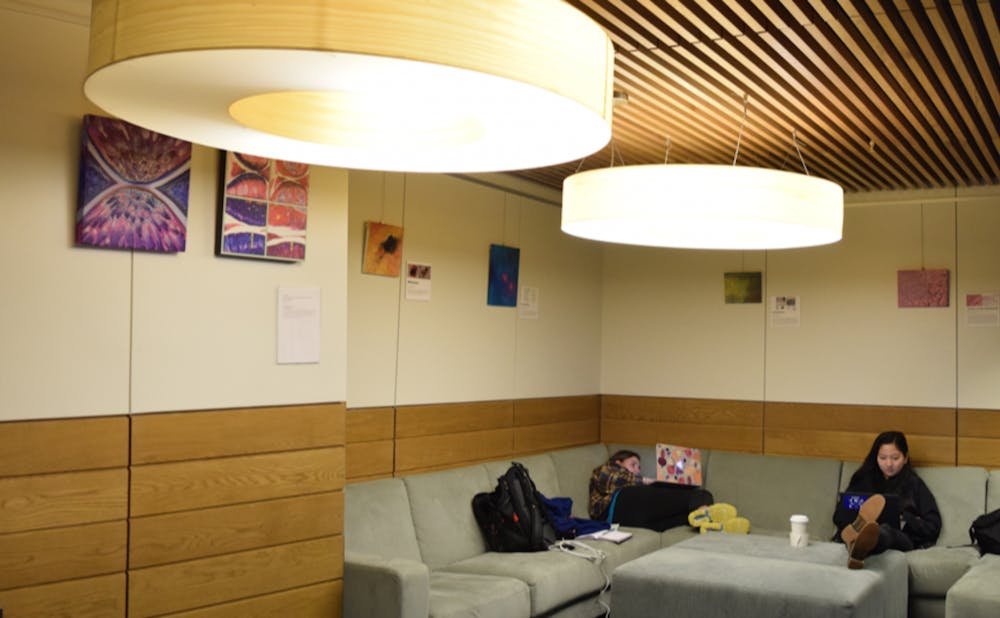The lounge area in front of Au Bon Pain in the Brodhead Center is normally bustling with students waiting for their chicken salad and chatting with their friends. However, next to the area is a peaceful room with cozy chairs and an exhibition titled the “Art of Science.” Organized by duARTS, the exhibit displays the paintings of senior Kelsey Graywill, who turns scanned images of diseases from research labs at Duke into artwork. The area was meant to house regular exhibits, but until Graywill’s work began to be displayed last semester, the exhibit was left unmaintained.
As a Program II major in “evolutionary neuro-aesthetics,” Graywill got the inspiration for the gallery from her interdisciplinary background in art and neuroscience. Graywill’s father, a computer technician, and her mother, a designer, influenced her decision to learn how to use digital art programs from an early age. She also began to paint at the beginning of her senior year of high school.
After coming to college, Graywill began to integrate science into her art. She was fascinated to learn in her Neuroscience 101 class about the transition of neurons from a normal state to a diseased state. During the winter break of her sophomore year, she created one of the first works to be displayed in the gallery, “Schizophrenia,” which shows disordered neurons in a schizophrenic brain.
When West Union was still under renovation, Graywill became a part of a sub-committee under DSG’s Facilities and Environment Committee. While the sub-committee organized three exhibitions that would be in the new building, she was specifically in charge of setting up an exhibit that would integrate art and science. She originally planned to receive data from research labs at Duke and have students do artistic renditions of it.
But Graywill had to modify her plan when the sub-committee faced several problems. The Facilities and Environment committee, where her sub-committee belonged, was not responsible for displaying artworks on campus when Graywill was a part of it. As its members graduated, the sub-committee began to fall apart, leaving her as its only remaining member.
By the time West Union finally opened, the sub-committee had disappeared. With only two paintings — Graywill’s painting of schizophrenia and another painting by a now-graduated student — hanging on the wall, the exhibit was left unmaintained.
The place came to life again at the beginning of the last Fall semester.
“When I became president of duARTS, I knew one of the things that I wanted to do was to revitalize [the exhibit space] and make it into at least something it was supposed to be,” Graywill said.
Temporarily displaying paintings that she created throughout her years at Duke in the exhibit, Graywill and the board members began to receive submissions for rotating exhibitions that will be held in the gallery. Exhibitions of student works with diverse topics ranging from women in neurosurgery to the art of speech patterns are planned for this semester.
Graywill said exhibitions that focus on the integration of art and science have become more common at Duke recently.
“For a very long time, art was a very small community [that was] not well-established at Duke,” she said. “But now that the university is making more investments in the arts, like the new [Rubenstein Arts Center], we want to draw in more students from different backgrounds and academic interests into the arts.”
With this merging of art and science, Graywill said she hopes students discover connections between the two.
“I want people to see how art and science are inherently about two same things, observation and discovery,” she said. “I think we use art to observe life very closely, and that is also what we do with science.”
Although “Art of Science” is the only gallery in Brodhead Center that Graywill manages, there are other exhibitions in the building. A gallery next to CaFe, which is maintained by Danielle Smith, an M.F.A. student in Experimental and Documentary Arts and Kevin Erixson, student development coordinator of the arts, displays the works of local artists. Placing the galleries in an easily accessible place like the Brodhead Center fulfilled these managers’ goal of making art more accessible at Duke.
“Seeing how much arts are being included in Duke is really exciting,” Smith said. “People can actually interact with [the arts] and be parts of them.”
They also hoped that students would gain new experiences at the galleries.
“[The galleries] allow students to have conversations,” Erixson said. “They are also opportunities for students to experience something different from their day to day lives.”
Get The Chronicle straight to your inbox
Signup for our weekly newsletter. Cancel at any time.

